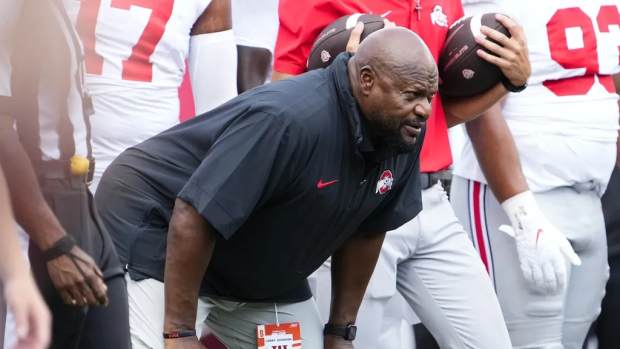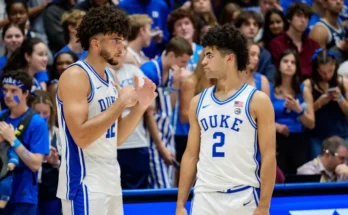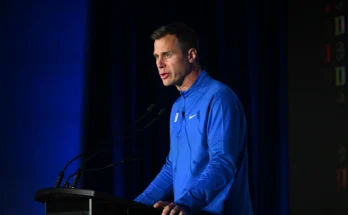Ryan Day shows concern over position facing major turnover, ‘there needs to be more growth’
In the world of college football, where high expectations often hang over the heads of coaches, players, and teams, Ryan Day, head coach of Ohio State University’s football program, has expressed significant concern regarding the major turnover facing his team. With the program experiencing shifts in its personnel and leadership, Day has made it clear that growth and development will be central to their future success. His remarks have sparked a conversation about how the Buckeyes will navigate a transitional phase and rise to meet the challenges ahead.
The Landscape of College Football and Ohio State’s Challenges
The nature of college football means that teams are constantly evolving. Players come and go, with a significant portion of the roster graduating or declaring for the NFL draft. This turnover is particularly pronounced at powerhouse programs like Ohio State, which consistently recruits top-tier talent. However, the loss of key players from both the coaching staff and the roster is a unique challenge, as it places the emphasis not only on recruiting new talent but also on developing the incoming and returning players into contributors.
For Ryan Day, leading Ohio State through this transition has been a task filled with both promise and pressure. Ohio State is known for its high expectations, with its rich history, storied traditions, and consistent presence in the College Football Playoff discussions. The turnover, however, has created a situation in which Day is looking at a team with several key positions in flux, especially in areas like quarterback, wide receiver, and the defensive line.
The concern comes from the fact that, despite a steady flow of talent from the recruiting pipeline, development within the program must happen rapidly to maintain the program’s level of competitiveness. For Day, the coaching staff must find ways to ensure the next generation of Buckeye stars not only learn from the veterans but also exceed the standards set by their predecessors.
The Quarterback Position: A Major Source of Concern
Perhaps the most significant area of concern for Ryan Day revolves around the quarterback position. Ohio State has become synonymous with producing elite quarterbacks over the years. From Braxton Miller to J.T. Barrett and Dwayne Haskins, and more recently, Justin Fields, the Buckeyes have seen a wealth of talent at the most important position on the field. The departure of these quarterbacks and the challenges of filling that void have left Day contemplating the growth of the next man up.
Ohio State’s quarterback room is no longer just a matter of recruiting talent; it is about ensuring that the young quarterbacks are not only physically capable but mentally prepared for the demands of leading one of college football’s premier programs. Day has made it clear that he expects growth in this position, acknowledging that both the coaching staff and the quarterbacks themselves will have to go through a process of maturation. The turnover at this key position underscores a critical issue: how well can a young quarterback develop into an elite talent in a program with championship aspirations?
The loss of Fields to the NFL left a significant gap in the Buckeyes’ quarterback depth chart. This has created a situation where Day will need to work with relatively inexperienced quarterbacks, a challenge that has not been faced in recent years. For the Buckeyes, finding stability and growth at quarterback is non-negotiable, as this position is critical to the overall success of the team.
Wide Receiver Turnover and Offensive Adjustments
In addition to the quarterback situation, Ohio State faces a similar issue with its wide receivers. The program has seen significant turnover in its wide receiver room, with several key players departing for the NFL, including standout talents like Chris Olave and Garrett Wilson. These departures have created a void in terms of experience and leadership at one of the most crucial positions in the passing game.
Ryan Day’s offensive philosophy revolves around an up-tempo, high-scoring attack, with the wide receivers often playing a central role in that scheme. The turnover at this position means that the Buckeyes will have to lean on a mix of younger players and potentially underutilized talents to step into bigger roles. This is where Day’s ability to develop talent becomes vital.
The challenge here is not just finding replacement-level players but ensuring that the new crop of wide receivers can assimilate into the team’s high-paced, high-expectation offensive system. Ohio State’s offense has long relied on its wide receiver corps to be one of the best in the nation, and the team’s future success hinges on how quickly these new players can adapt.
Day, in his press conferences, has expressed a belief in the talent available in his wide receiver room but also recognizes that there must be rapid growth. While talent alone is important, the ability to translate that into production in real-game scenarios is the difference between championship contention and mediocrity.
Defensive Turnover: The Challenge of Rebuilding
The turnover issues for Ohio State are not confined to the offensive side of the ball. The defense, too, has seen its share of key losses. With the departure of defensive stars, the coaching staff will be faced with the challenge of rebuilding the defensive unit while maintaining the same level of excellence that has made Ohio State one of the most formidable teams in the country on that side of the ball.
Ryan Day has voiced concern about the defensive line, an area of the game that has traditionally been a strength for the Buckeyes. The defensive line is often the backbone of Ohio State’s defense, setting the tone for the entire unit. The losses of experienced players to the NFL have created gaps that will need to be filled. Much like with the offense, Day believes that growth will be key. The defensive line will need young players to step up and make an immediate impact.
The challenge here is also related to coaching. Day has acknowledged that while the players may have the raw talent needed to succeed, the coaching staff must work diligently to ensure that these players understand their roles and develop the technical skills needed to compete at a high level.
Day’s emphasis on growth suggests that he is aware of the need for quick adaptation and improvement within the defensive ranks. This is especially true given the competitive nature of the Big Ten and the rising talent across college football. As Ohio State is regularly pitted against some of the nation’s most talented offenses, the defense must rise to the occasion.
Ryan Day’s Leadership and the Path Forward
As Ohio State navigates this period of transition, the leadership of Ryan Day will be tested. Day, who took over the program in 2019, has already established himself as a coach capable of achieving success on the national stage. However, leading a team through significant turnover is a different challenge entirely. It requires not just recruiting and developing talent but also instilling a culture of growth, resilience, and adaptability.
Day has made it clear that there is no room for complacency. The challenge is to turn the turnover into an opportunity for growth, ensuring that the players on the roster develop into leaders and contributors. He has also stressed the importance of the coaching staff’s role in developing the team. A successful program is one that not only attracts talent but also nurtures it to reach its full potential.
While Ohio State faces a period of transition, Day’s comments suggest that he believes the program is in a position to continue competing at a high level. However, that success will depend on how well the Buckeyes can address the turnover, especially in key positions like quarterback, wide receiver, and the defensive line.
For Ryan Day, the path forward is clear: there needs to be growth. Growth in the players’ development, growth in the team’s cohesion, and growth in the leadership that will guide Ohio State through the coming seasons. The concerns Day has expressed are not just a reflection of the challenges ahead, but also a call to action. If the Buckeyes can meet this challenge, they will be positioned for continued success at the highest level. But if growth falters, the program may struggle to meet the high expectations that come with wearing the scarlet and gray.
Ultimately, Ryan Day’s leadership and the growth of his players will determine whether Ohio State continues to thrive or falls short of its lofty ambitions. The coming seasons will be pivotal, and the emphasis on growth, both individually and as a team, will likely shape the Buckeyes’ trajectory.
As Day himself said, “There needs to be more growth,” and it’s clear that the future of Ohio State football hinges on how effectively the team and its coach rise to this challenge. With the right adjustments and development, Ohio State has the potential to emerge even stronger from this period of turnover and continue its tradition of excellence in college football.



